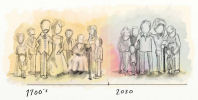For reference:
Jason Kenney in his Backgrounder for his immigration hearing in 2011
“That being said, research underscores that immigration is not a viable remedy for population aging. A 2009 study by the C.D. Howe Institute concludes that improbably huge increases in immigration (i.e. from the current 0.8% to nearly 4% ** of the population) in the short term would be required to stabilize Canada’s current old-age dependency ratio.”
Backgrounder - Stakeholder Consultations on Immigration Levels and Mix
http://www.cic.gc.ca/english/department/media/backgrounders/2011/2011-07-11.asp
Library of Parliament - Immigration to Canada pdf PRB0350-e - Page 9
“Finally it is worth noting that in 2000, the UN Population Division conducted a study of whether replacement migration could solve the problem of population aging and decline. Using a scenario that simulates the migration required to maintain the dependency ratio the study concluded that the level of immigration to offset population aging would have to be much higher than in the past. For example the United States would have to admit 592 million immigrants between 2000 and 2050 to keep its dependency steady. The population of the United States was 274 million in 2000. This would mean nearly 11 million immigrants each year, compared with 1.5 million at present – not a very realistic scenario”
**The Math: 4% = 1.5 million per
year or 7 new City of Torontos every 10 years,
Compound growth – doubling every 17 years for a population of 36 billion in 2170





Recent comments